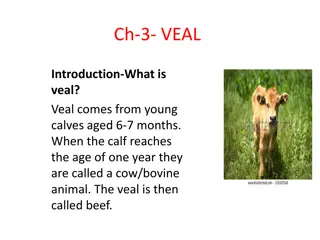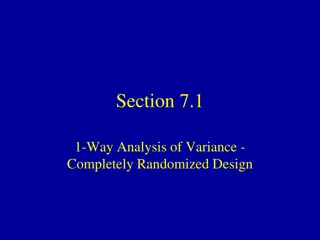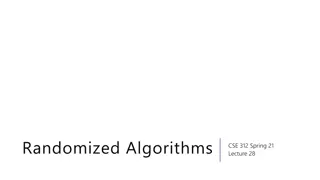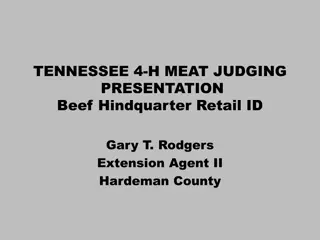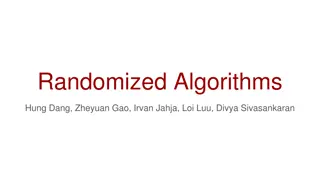
Randomized Algorithms for Cuts and Colouring in Distributed Computation
Explore the world of distributed computation and randomized algorithms for cuts and colouring. Discover how randomness can check 3-edge connectivity, find disjoint set covers, and compute global graph properties efficiently. Delve into message passing complexities, known time complexities, and the main results of distributed algorithms.
Download Presentation

Please find below an Image/Link to download the presentation.
The content on the website is provided AS IS for your information and personal use only. It may not be sold, licensed, or shared on other websites without obtaining consent from the author. If you encounter any issues during the download, it is possible that the publisher has removed the file from their server.
You are allowed to download the files provided on this website for personal or commercial use, subject to the condition that they are used lawfully. All files are the property of their respective owners.
The content on the website is provided AS IS for your information and personal use only. It may not be sold, licensed, or shared on other websites without obtaining consent from the author.
E N D
Presentation Transcript
Randomized Algorithms for Cuts and Colouring David Pritchard, NSERC Post-doctoral Fellow
What Can Randomness Do? Part 1: Check 3-edge-connectivity in a distributed network Joint with Ramakrishna Thurimella (Denver) Part 2: Find many disjoint set covers as a function of min degree Joint w/ B la Bollob s (Cambridge & Memphis), Thomas Rothvo (MIT), Alex Scott (Oxford)
Distributed Computation Vertices are computers that communicate using edges initially, local/no knowledge goal: compute global graph property
Distributed Computation Message passing happens in rounds time complexity: # rounds elapsed Diameter := maximum distance (# hops) between two nodes e.g., Diam = 5
Distributed Computation Message passing happens in rounds time complexity: # rounds elapsed Diameter := maximum distance (# hops) between two nodes if message lengths are unrestricted, we can compute anything in O(Diameter) rounds CONGEST model: limit message lengths to O(log |V|) bits
Known Time Complexities Synchronizer w/polylog overhead, AP 90 Breadth-first spanning tree: O(Diam) time Universally optimal
Known Time Complexities Synchronizer w/polylog overhead, AP 90 Breadth-first spanning tree: O(Diam) time Universally optimal Depth-first spanning tree: O(|V|) time; no good lower bound Min-cost spanning tree (KP 98, PR 99): O( V log*V + Diam), ( V/log V)
Main Result Distributed algorithm to check 3-edge- connectivity in O(Diam) time explicit: finds 2-edge-cuts application: reinforcement beats prior O(Diam+V2); optimal Main tool: sample cycle space randomly
Main Tool: Cycle Space connected network/graph (V, E) (V, F) Eulerian if v, degF(v) is even Cycle space := the vector space {F : (V, F) is Eulerian} notation abuse: F is a subset of E and also its characteristic vector {0, 1}E why is it a vector space? even deg. even deg. even deg. =
Random Sampling Claim: if T is a spanning tree, any 0-1 vector on E\T extends uniquely to an Eulerian subgraph F thick: T green: in F red: not in F grey: undecided Corollary: sampling from the cycle space uniformly is as easy as sampling 2E\T
Cuts and Cycles Claim. | (S) F| is even for all Eulerian F use Euler tour(s)! Claim. Unless E = (S) for some S, for a random F from the cycle space, |E F| is even exactly of the time.
Finding 2-Edge Cuts? 2 edges {e, e } form a cut |{e, e } F| even for all Eulerian F e and e always both or neither in F Implies transitivity: if {e, f} and {f, g} are 2-edge cuts, so is {e, g} Call equivalence classes cut classes cut class some edges not in any 2-edge-cuts
Algorithm for 2-Edge Cuts Set k = O(log |V|). Sample F1, F2, Fk from cycle space. Group equal rows and output them as cut classes. {ei, ej} is a 2-edge-cut ei, ej have equal rows, with error probability 2-k Pr[any error] |E|22-k = 1/poly(V) F1 F2 F3 F4 F5 F6 1 0 1 1 1 1 0 1 0 1 0 1 1 0 1 0 1 0 1 0 1 0 1 0 0 1 0 1 0 1 e1 e2 e3 e4 e5 1 0 1 1 0
Questions Leads to O(Diam + /log V)-time algorithm for cut vertices O(Diam + V log*V) known before (Thurimella 97) Is O(Diam) possible or not? Can this be derandomized? in a distributed way?
Festival Scheduling Set V of musicians, list of bands V A schedule maps each band to a day Each musician must play every day What is max # days in schedule?
The Basic Question Input: A set system/hypergraph (V, H) each S H is a hyperedge S V A cover-decomposition is a partition H = H1 H2 Hk s.t. each Hi covers V, i.e. {S | S Hi} = V equivalently, a polychromatic coloring goal: maximize #parts/#colours
cd: Cover-Decomposition Number cd(H) largest k for which there is a cover-decomposition into k parts Easy: cd minimum degree Does a converse hold? If 100 (H covers every point 100 times), can we get many disjoint covers? In general, no: cd = 1 is still possible But for specific families
Cover-Decomposition in Graphs R. P. Gupta, 1970s: In a graph, cd -1. In a multigraph, cd 3 +1/4 . Tight multigraph examples: =2 cd=1 =3 cd=2 =4 cd=3
Cover-Decomposition in Geometry Ground set = finite X Rd, edges = subsets of X covered by shapes
Cover-Decomposition in Geometry cd = ( ) Translates of any convex polygon Axis-aligned strips Axis-aligned rectangles Halfspaces in 2D 3D orthants not cover-decomposable Translates of any non- convex quadrilateral Conjecture [Pach, 1980]: for any fixed convex set S, there is S, so that hypergraphs with a finite ground set in R2 and translates of S as edges, with S, have cd(H) 2. The family is cover-decomposable. Unit strips in 2D 4D orthants
Our Results Hypergraphs with bounded edge size R cd /log R; Techniques: LLL, discrepancy, LPs Hypergraphs of paths in trees cd /5 hypergraph families as possible. this is tight Goal: find out how cover-decomposition number (cd) depends on minimum degree ( ) in as many natural Hypergraphs of VC-dimension D cover-decomposable only for D = 1
/ Lovasz Local Lemma: There are any number of bad events, but each is independent of all but D others. LLL: If each bad event has individual probability at most 1/eD, then Pr[no bad events happen] > 0. Natural to try in our setting: randomly k-colour the edges
Edge size R Pick some k, randomly k-colour edges. bad event: vertex v misses colour c. Dependence degree k R (max degree) set all degrees to by shrinking Analyze: Pr[v misses c] (1-1/k) e- /k Need Rk e- /k < 1/e dependency degree cd ( /(log R + log )) v S S\{v}
Splitting the Hypergraph ( /log R ) is already ( /log R) if poly(R) Idea: partition edges to H1,H2, ,HM with (Hi) poly(R), (Hi) ~ (H)/M ( (Hi)/log R) covers = ( (H)/M/log R) covers ( (H)/M/log R) covers ( (H)/M/log R) covers M=3 ~ /log R covers
Iterated Pairwise Splitting Split H into H+, H- so that v, : deg(v, H ) deg(v, H)/2 - Equivalent view: assign 1 to edges, s.t. |total weight on each vertex| 2 discrepancy! Beck-Fiala 1981: there is an assignment with discrepancy 2R
Beck-Fiala Algorithm LP variables: S: 0 xS = 1 - yS 1 v: S:v S xS /2, S:v S yS /2 1. find extreme point LP solution 2. fix variables with values 0 or 1 3. discard all constraints involving R non-fixed variables Termination lemma |Hnonfixed|; each var is in R constraints basis of tight degree constraints has size
Remarks Maximum edge size R: use better discrepancy bound to get right multiplicative constant Concentration/LLL instead of B-F cd /5 for paths in trees: B-F, different termination lemma linear independence of basis
Sparse Hypergraphs [Alon-Berke-Buchin2-Csorba-Shannigrahi-Speckmann-Zumstein] ( , )-sparse hypergraph := incidences(U V, F H) |U|+ |F| : -vertex-sparse incidences -edge-sparse incidences idea: shrink off -edge-sparse ones, obtaining cd ( - )/log bipartite incidence graph vertices hyperedges
Cover Scheduling Hyperedges are sensors monitoring V Each hyperedge S has battery life dS Goal: schedule when each should turn on, so V is covered from time 0 to T How large can T be? (Cover-decomposition: d 1) Result: (min point coverage/R) schedule is possible Open Q: improve R to log R!





